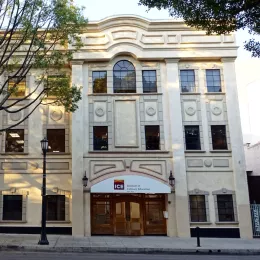Kitchen 601 transformed into a butcher shop this week as we completed the last of our lessons on meat fabrication.
We watched carefully as Chef Ted demonstrated each cut and technique on varying sections of beef, veal, pork, rabbit, and lamb. We began each lesson with a short lecture outlining the slaughtering processes and quality grades of each protein. I took particular interest in our discussion of beef fabrication, as Chef Ted highlighted the key factors used to determine the grade of the meat. He noted that the color of the flesh, the composition of the fat, the bones and the amount of marbling all determine whether the beef receives a prime, choice, select, standard or commercial grade. The lowest three grades, utility, canner and cutter, are used for institutional food processing. Also important is the code number used to classify each piece of meat (this is not specific to beef) in the North American Meat Purveyors Guide (N.A.M.P. Guide).
With a basic understanding of beef, we sharpened our knives and tackled the #180 boneless beef loin, a tender section that sits close to the carcass. We then moved on to the #189 beef tenderloin from which we fashioned tournedos, chateaubriand, medallions and filet mignon. We completed our lesson in beef fabrication with the #193 flank steak. And that was just Monday!
Tuesday marked the start of veal fabrication. Chef Ted walked us step-by-step through fabricating the veal by first boning out the veal loin with the flank attached. We then fabricated a boneless veal loin roast and cut veal scaloppini and cutlets. My favorite part came when it was time to truss the tenderloin, a technique I had been dying to learn. We fashioned slipknots around the tenderloin, creating a uniformly thick cut of meat for even cooking (slideshow image #3). We also fabricated the kidneys (slideshow image #5) and chopped up the bones for a veal stock we made later in the week.
With the beef and veal meat fabrication behind us, we moved on to fabricating pork, which included Frenching (scraping completely clean) the bones of the pork chops (slideshow image #8). Wednesday ended with an intricate demo as to how to disjoint a rabbit and fabricate a boneless rabbit saddle (slideshow image #9). We sharpened our knives one last time to fabricate an entire lamb leg, which included removing the leg and hip bones. The final lesson in fabrication included Frenching the bones of a rack of lamb. All in all, the week was a success as Chef Ted laid the foundation for the proteins we will be cooking in the weeks and months ahead.
Coming up next week: Clarified Butter, Rouxs, Slurries & Beurre Manie, The Mother Sauces, Emulsion Sauces and Contemporary Sauces
A look back: Lesson 1: Mise en Place Lesson 5: Medium Dice & Mirepoix Lessons 6-10: Fabrication & Stocks



